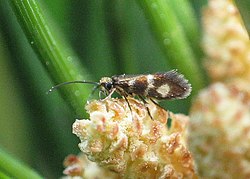| Micropterigidae Temporal range: | |
|---|---|
 | |
| Micropterix aureoviridella (Höfner, 1898) | |
| Scientific classification | |
| Kingdom: | Animalia |
| Phylum: | Arthropoda |
| Class: | Insecta |
| Order: | Lepidoptera |
| Suborder: | Zeugloptera Chapman, 1917 [1] |
| Superfamily: | Micropterigoidea Herrich-Schäffer, 1855 |
| Family: | Micropterigidae Herrich-Schäffer, 1855 |
| Genera | |
See text | |
| Diversity | |
| About 180 species | |
Micropterigoidea is the superfamily of "mandibulate archaic moths", all placed in the single family Micropterigidae, containing currently about twenty living genera. They are considered the most primitive extant lineage of lepidoptera (Kristensen, 1999), and the sole superfamily in the suborder Zeugloptera. The name comes from the Greek for mikros, little and pterux, a wing. [2] Unique among the Lepidoptera, these moths have chewing mouthparts rather than a proboscis, and are seen feeding, often in large aggregations, on the pollen of the flowers of many herbaceous plants, shrubs and trees. [3] [4] The fossil record of the group goes back to the middle-late Jurassic with the earliest known species being Auliepterix from the Karabastau Formation in Kazakhstan.
Contents
